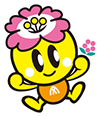活気あふれるまち「大和高田」ができました。
「商都高田」の誕生です。
As the public utilities such as water, electricity and roads developed, Yamato Takada saw many factory workers moving into the town. Then, shopping streets and movie theaters were built to accommodate the shopping and entertainment needs of the growing population.
As a result, Yamato Takada became a very lively town and
a renowned commercial town.
・昭和のはじめ、日本は世界最大の綿糸紡績の産業国となりました。
In the beginning of the Showa period, Japan had one of the largest cotton spinning industries in the world.
―酒本さんのお話―
「大きな戦争がおこって、全国にあるいろいろな工場は空襲にあい焼失しましたが、大日本紡績高田工場は、無事でした。そのため、全国の紡績をうけおいました。こうして戦争という時代を乗り越えました。
工場では、3000人の女子工員さん達が働いていました。この人たちや家族の人々が戦後も大和高田の町のにぎわいを支えました。」
Interview with Mr. Sakamoto
“Various factories throughout Japan were burned up in air strikes during the war but no harm came to Dainihon Cotton Spinning Company Takada Factory. So, the factory undertook spinning work from all over the country and survived through the war.
There were 3,000 female workers in the factory. These workers and their family members continued to support the livelihood of Yamato Takada after the war. ”
・昭和40年代に入ると、日米経済摩擦により機械が減らされたり、またオイルショックも起こり環境が大きく変わりました。
The 1960s brought with them various changes in the business environment, such machine shortages due to Japan-US economic friction and oil crisis.
 | オイルショックというのは、原油の値段があがって経済が混乱することだよ。 An oil crisis is a sudden rise of crude oil prices accompanied with economic chaos. |
 ひとくちメモ Note ひとくちメモ Note |
| <にちべいけいざいまさつ 日米経済摩擦> 日本とアメリカ合衆国との経済関係が悪化した現象。高度経済成長以降、日本製品の輸出がアメリカの輸入を上まわるようになると、日本が貿易黒字になる状態が長く続いて、アメリカの産業界の反発が強まった。1969年のせんい摩擦からはじまり、鉄鋼、カラーテレビ、自動車、半導体などのハイテク分野へと摩擦は広がった。 『ポプラディア事典より』 |
| Japan‐US economic friction This refers to worsening economic relations between Japan and the US. After an era of high economic growth in Japan following World War II, Japan’s exports to the U.S. continued to surpass imports from the U.S., which brought a continuous trade surplus for Japan but intensified opposition from US industries. The Japan‐US economic friction, which started with textiles in 1969, gradually spread to other sectors such as steel, color TVs, automobiles, and semiconductors. (Source: Poplardia Encyclopedia) |
・大日本紡績高田工場は、その後「ユニチカ」と名前をかえ、昭和53年(1978年)の全面閉鎖まで大和高田のシンボル的な存在でした。
Dainihon Cotton Spinning Company Takada Factory was later renamed “Unitika,” and remained a factory symbolic of Yamato Takada until its complete shutdown in 1978.
・昭和14年(1939年)、日本で「ビニロン」という化学せんいが開発され、アクリルせんいが昭和25年(1950年)アメリカで工業生産がはじまりました。
In 1939, a synthetic fiber called vinylon was first developed in Japan. Industrial production of acrylic fiber began to take place in the U.S. in 1950.
・安価な化学せんいの発展で、綿紡績の需要が減ってきました。
With the development of cheap synthetic fibers, the demand for cotton spinning decreased.
・昭和53年、ユニチカは再開発を目的とした大型ショッピングセンター「ユニチカ・オークタウン」に建てかえ、スーパー「ダイエー」が入りました。
In 1978, Unitika was rebuilt into a large-scale shopping center, Unitika Oak Town, aiming for economic redevelopment. It welcomed Daiei supermarket as a tenant.


